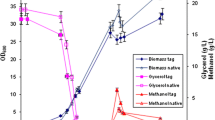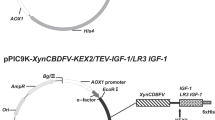Abstract
Relaxin family peptides are a group of peptide hormones with divergent biological functions. Mature relaxin family peptides are typically composed of two polypeptide chains with three disulfide linkages, rendering their preparation a challenging task. In the present study, we established an efficient approach for preparation of the chimeric relaxin family peptide R3/I5 through secretory overexpression in Pichia pastoris and in vitro enzymatic maturation. A designed single-chain R3/I5 precursor containing the B-chain of human relaxin-3 and the A-chain of human INSL5 was overexpressed in PichiaPink strain 1 by high-density fermentation in a two-liter fermenter, and approximately 200 mg of purified precursor was obtained from one liter of the fermentation supernatant. We also developed an economical approach for preparation of the uniformly 15N-labeled R3/I5 precursor by culturing in shaking flasks, and approximately 15 mg of purified 15N-labeled precursor was obtained from one liter of the culture supernatant. After purification by cation ion-exchange chromatography and reverse-phase high performance liquid chromatography, the R3/I5 precursor was converted to the mature two-chain form by sequential treatment with endoproteinase Lys-C and carboxypeptidase B. The mature R3/I5 peptide had an α-helix-dominated conformation and retained full receptor-binding and receptor activation activities. Thus, Pichia overexpression was an efficient approach for sample preparation and isotopic labeling of the chimeric R3/I5 peptide. This approach could also be extended to the preparation of other relaxin family peptides in future studies.






Similar content being viewed by others
References
Bathgate RA, Halls ML, van der Westhuizen ET, Callander GE, Kocan M, Summers RJ (2013) Relaxin family peptides and their receptors. Physiol Rev 93:405–480
Chan LJ, Hossain MA, Samuel CS, Separovic F, Wade JD (2011) The relaxin peptide family–structure, function and clinical applications. Protein Pept Lett 18:220–229
Cregg JM, Tolstorukov I, Kusari A, Sunga J, Madden K, Chappell T (2009) Expression in the yeast Pichia pastoris. Methods Enzymol 463:169–189
Damasceno LM, Huang CJ, Batt CA (2012) Protein secretion in Pichia pastoris and advances in protein production. Appl Microbiol Biotechnol 93:31–39
Hsu SY, Nakabayashi K, Nishi S, Kumagai J, Kudo M, Sherwood OD, Hsueh AJ (2002) Activation of orphan receptors by the hormone relaxin. Science 295:671–674
Ivell R, Kotula-Balak M, Glynn D, Heng K, Anand-Ivell R (2011) Relaxin family peptides in the male reproductive system–a critical appraisal. Mol Hum Reprod 17:71–84
Kjeldsen T, Pettersson AF, Hach M (1999) Secretory expression and characterization of insulin in Pichia pastoris. Biotechnol Appl Biochem 29:79–86
Kong RC, Shilling PJ, Lobb DK, Gooley PR, Bathgate RA (2010) Membrane receptors: structure and function of the relaxin family peptide receptors. Mol Cell Endocrinol 320:1–15
Kumagai J, Hsu SY, Matsumi H, Roh JS, Fu P, Wade JD, Bathgate RA, Hsueh AJ (2002) INSL3/Leydig insulin-like peptide activates the LGR8 receptor important in testis descent. J Biol Chem 277:31283–31286
Li P, Anumanthan A, Gao XG, Ilangovan K, Suzara VV, Düzgüneş N, Renugopalakrishnan V (2007) Expression of recombinant proteins in Pichia pastoris. Appl Biochem Biotechnol 142:105–124
Liu C, Chen J, Sutton S, Roland B, Kuei C, Farmer N, Sillard R, Lovenberg TW (2003a) Identification of relaxin-3/INSL7 as a ligand for GPCR142. J Biol Chem 278:50765–50770
Liu C, Eriste E, Sutton S, Chen J, Roland B, Kuei C, Farmer N, Jörnvall H, Sillard R, Lovenberg TW (2003b) Identification of relaxin-3/INSL7 as an endogenous ligand for the orphan G-protein-coupled receptor GPCR135. J Biol Chem 278:50754–50764
Liu C, Chen J, Kuei C, Sutton S, Nepomuceno D, Bonaventure P, Lovenberg TW (2005a) Relaxin-3/insulin-like peptide 5 chimeric peptide, a selective ligand for G-protein coupled receptor (GPCR)135 and GPCR142 over leucine-rich repeat-containing G-protein coupled receptor 7. Mol Pharmacol 67:231–240
Liu C, Kuei C, Sutton S, Chen J, Bonaventure P, Wu J, Nepomuceno D, Kamme F, Tran DT, Zhu J, Wilkinson T, Bathgate R, Eriste E, Sillard R, Lovenberg TW (2005b) INSL5 is a high affinity specific agonist for GPCR142 (GPR100). J Biol Chem 280:292–300
Luo X, Bathgate RA, Zhang WJ, Liu YL, Shao XX, Wade JD, Guo ZY (2010a) Design and recombinant expression of insulin-like peptide 5 precursors and the preparation of mature human INSL5. Amino Acids 39:1343–1352
Luo X, Liu YL, Layfield S, Shao XX, Bathgate RA, Wade JD, Guo ZY (2010b) A simple approach for the preparation of mature human relaxin-3. Peptides 31:2083–2088
Mattanovich D, Branduardi P, Dato L, Gasser B, Sauer M, Porro D (2012) Recombinant protein production in yeasts. Methods Mol Biol 824:329–358
Shabanpoor F, Separovic F, Wade JD (2011) General method for selective labelling of double-chain cysteine-rich peptides with a lanthanide chelate via solid-phase synthesis. J Pept Sci 17:169–173
Shabanpoor F, Akhter Hossain M, Ryan PJ, Belgi A, Layfield S, Kocan M, Zhang S, Samuel CS, Gundlach AL, Bathgate RA, Separovic F, Wade JD (2012) Minimization of human relaxin-3 leading to high-affinity analogues with increased selectivity for relaxin-family peptide 3 receptor (RXFP3) over RXFP1. J Med Chem 55:1671–1681
Shabanpoor F, Hossain MA, Lin F, Wade JD (2013a) Sequential formation of regioselective disulfide bonds in synthetic peptides with multiple disulfide bonds. Methods Mol Biol 1047:81–87
Shabanpoor F, Bathgate RAD, Wade JD, Hossain MA (2013b) C-terminus of the B-chain of relaxin-3 is important for receptor activity. PLoS ONE 8:e0082567
Sudo S, Kumagai J, Nishi S, Layfield S, Ferraro T, Bathgate RA, Hsueh AJ (2003) H3 relaxin is a specific ligand for LGR7 and activates the receptor by interacting with both the ectodomain and the exoloop 2. J Biol Chem 278:7855–7862
van der Westhuizen ET, Halls ML, Samuel CS, Bathgate RA, Unemori EN, Sutton SW, Summers RJ (2008) Relaxin family peptide receptors–from orphans to therapeutic targets. Drug Discov Today 13:640–651
Wade JD, Lin F, Hossain MA, Shabanpoor F, Zhang S, Tregear GW (2009) The chemical synthesis of relaxin and related peptides. Ann N Y Acad Sci 1160:11–15
Wang XY, Guo YQ, Zhang WJ, Shao XX, Liu YL, Xu ZG, Guo ZY (2014) The electrostatic interactions of relaxin-3 with receptor RXFP3 and the influence of its B-chain C-terminal conformation. FEBS J 281:2927–2936
Zhang WJ, Gao XJ, Liu YL, Shao XX, Guo ZY (2012a) Design, recombinant preparation and europium-labeling of a fully active easily-labeled INSL3 analogue for receptor-binding assays. Process Biochem 47:1856–1860
Zhang WJ, Luo X, Song G, Wang XY, Shao XX, Guo ZY (2012b) Design, recombinant expression and convenient A-chain N-terminal europium-labelling of a fully active human relaxin-3 analogue. FEBS J 279:1505–1512
Zhang WJ, Jiang Q, Wang XY, Song G, Shao XX, Guo ZY (2013) A convenient method for europium-labeling of a recombinant chimeric relaxin family peptide R3/I5 for receptor-binding assays. J Pept Sci 19:350–354
Zhang WJ, Wang XY, Guo YQ, Luo X, Gao XJ, Shao XX, Liu YL, Xu ZG, Guo ZY (2014) The highly conserved negatively charged Glu141 and Asp145 of the G-protein-coupled receptor RXFP3 interact with the highly conserved positively charged arginine residues of relaxin-3. Amino Acids 46:1393–1402
Acknowledgments
This work was supported by grants from the National Natural Science Foundation of China (31270824, 30970609) and the Fundamental Research Funds from Tongji University.
Conflict of interest
The authors declare that they have no conflict of interest.
Author information
Authors and Affiliations
Corresponding author
Additional information
Handling Editor: M. S. Palma.
Y.-Q. Guo and Q.-P. Wu contributed equally to this work.
Rights and permissions
About this article
Cite this article
Guo, YQ., Wu, QP., Shao, XX. et al. Secretory overexpression and isotopic labeling of the chimeric relaxin family peptide R3/I5 in Pichia pastoris . Amino Acids 47, 1117–1125 (2015). https://doi.org/10.1007/s00726-015-1939-8
Received:
Accepted:
Published:
Issue Date:
DOI: https://doi.org/10.1007/s00726-015-1939-8




